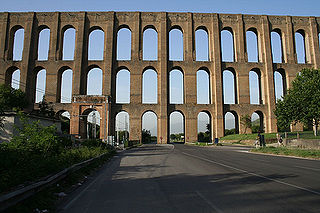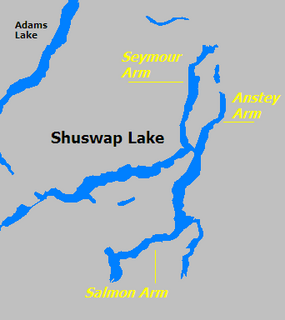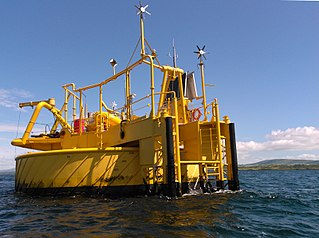 W
WAn anchorage is a location at sea where ships can lower anchors.
 W
WAqueducts or water bridges are bridges constructed to convey watercourses across gaps such as valleys or ravines. The term aqueduct may also be used to refer to the entire watercourse, as well as the bridge. Large navigable aqueducts are used as transport links for boats or ships. Aqueducts must span a crossing at the same level as the watercourses on each end. The word is derived from the Latin aqua ("water") and ducere, therefore meaning "to lead water". A modern version of an aqueduct is a pipeline bridge. They may take the form of tunnels, networks of surface channels and canals, covered clay pipes or monumental bridges.
 W
WCanals are waterway channels, or artificial waterways, for water conveyance, or for servicing water transport vehicles. They carry free surface flow under atmospheric pressure, and can be thought of as artificial rivers.
 W
WIn geography, an arm is a narrow extension, inlet, or smaller reach, of water flowing out from a much larger body of water, such as an ocean, a sea, or a lake. Although different geographically, a sound or bay may also be called an arm.
 W
WA canal basin is an expanse of waterway alongside or at the end of a canal, and wider than the canal, constructed to allow boats to moor or unload cargo without impeding the progress of other traffic, and to allow room for turning, thus serving as a winding hole. For inland waterways, a basin may be thought of as a land-locked harbour.
 W
WCanal safety gates or canal air raid protection gates are structures that were installed on canals specifically to reduce or prevent flood damage to dwellings, factories, etc. in the event of aqueducts, canal banks, etc. being breached either through natural events or by enemy action during wars, insurgency, sabotage, etc. They sometimes have a secondary function in regard of canal maintenance work. Substantial structures or simple 'stop gates' or 'stop planks' were used to prevent flooding and were usually only put in place when air raid warnings were given.
 W
WA canal tunnel is a tunnel for a canal. The building of a canal tunnel is crucial to help a waterway that is normally used for shipping cross a difficult section of terrain. They are also constructed to reduce the dependency on canal locks.
 W
WA cavana is a covered shelter for boats. They are typical of the city and lagoon of Venice.
 W
WA flood barrier, surge barrier or storm surge barrier is a specific type of floodgate, designed to prevent a storm surge or spring tide from flooding the protected area behind the barrier. A surge barrier is almost always part of a larger flood protection system consisting of floodwalls, levees, and other constructions and natural geographical features.
 W
WFloodgates, also called stop gates, are adjustable gates used to control water flow in flood barriers, reservoir, river, stream, or levee systems. They may be designed to set spillway crest heights in dams, to adjust flow rates in sluices and canals, or they may be designed to stop water flow entirely as part of a levee or storm surge system. Since most of these devices operate by controlling the water surface elevation being stored or routed, they are also known as crest gates. In the case of flood bypass systems, floodgates sometimes are also used to lower the water levels in a main river or canal channels by allowing more water to flow into a flood bypass or detention basin when the main river or canal is approaching a flood stage.
 W
WA ford is a shallow place with good footing where a river or stream may be crossed by wading, or inside a vehicle getting its wheels wet. A ford may occur naturally or be constructed. Fords may be impassable during high water. A low water crossing is a low bridge that allows crossing over a river or stream when water is low but may be covered by deep water when the river is high.
 W
WGracht is a Dutch word for a canal within a city. Grachten often have a round shape and form a circle around the city cores in the Netherlands, Belgium and northern Germany. Outside the Netherlands, the word grachten mostly refers to the city canals of Amsterdam, for which it is well known.
 W
WThe Gulf Intracoastal Waterway West Closure Complex is a part of the New Orleans Drainage System; it consists of a navigable floodgate, a pumping station, flood walls, sluice gates, foreshore protection, and an earthen levee. The complex was designed to reduce risk for residences and businesses in the project area from a storm surge associated with a tropical event, with an intensity that has a one percent chance of occurring in any given year. This project was operated for the first time on August 29, 2012, in response to Hurricane Isaac.
 W
WThe Gutzlaff Signal Tower, also known as the Bund Weather Tower or the Bund Signal Tower (外滩信号台), is a major landmark in Shanghai's Bund. It is a 36.8m tall signal station built in Art Deco style, originally intended to provide weather information to ships on the Huangpu River, in particular typhoon warnings.
 W
WThe canal network of the United Kingdom played a vital role in the Industrial Revolution. The canals permitted the creation of wealth, by industry, that led to the British Empire in the Victorian Era. The UK was the first country to develop a nationwide canal network, which expanded to nearly 4,000 miles in length. The canals allowed raw materials to be transported to a place of manufacture, and finished goods to be transported to consumers, more quickly and cheaply than via a land based route.
 W
WA lock is a device used for raising and lowering boats, ships and other watercraft between stretches of water of different levels on river and canal waterways. The distinguishing feature of a lock is a fixed chamber in which the water level can be varied; whereas in a caisson lock, a boat lift, or on a canal inclined plane, it is the chamber itself that rises and falls.
 W
WA naviduct is a special class of navigable aqueduct, in which the waterway also includes a lock. One example of a naviduct has been built at Enkhuizen on the Houtribdijk in the Netherlands on the instructions of the Rijkswaterstaat. This cost over €55 million and was completed in 2003. It is big enough to simultaneously transfer two large Rhine river-barges from the Markermeer to the IJsselmeer or vice versa. The structure was chosen because a busy waterway crosses a dam carrying a busy road, but the space available for separate aqueduct and lock facilities was restricted.
 W
WCanals are waterway channels, or artificial waterways, for water conveyance, or for servicing water transport vehicles. They carry free surface flow under atmospheric pressure, and can be thought of as artificial rivers.
 W
WPuddling is both the material and the process of lining a water body such as a channel or pond with puddle clay – a watertight material based on clay and water mixed to be workable.
 W
WA roving bridge, changeline bridge, turnover bridge, or snake bridge is a bridge over a canal constructed to allow a horse towing a boat to cross the canal when the towpath changes sides. This often involved unhitching the tow line, but on some canals they were constructed so that there was no need to do this by placing the two ramps on the same side of the bridge, which turned the horse through 360 degrees. On the Macclesfield Canal this was achieved by building spiral ramps and on the Stratford-upon-Avon Canal and others by constructing roving bridges of iron in two cantilevered halves, leaving a slot in the middle for the tow rope. This was also called a split bridge. For cost reasons many ordinary Stratford bridges were also built in this way as they had no towpath.
 W
WThe Scharhörnbake was the most important daymark on the German North Sea coast for a long time. First erected in 1661 by the City of Hamburg on the sandbank Scharhörn and south side of the Elbe estuary, it was rebuilt over centuries and taken down finally in 1979. Equipped with a room, it also functioned as a refuge beacon for shipwreck survivors from 1840 to 1965. The only remaining element today is the boulder stone foundation near Nigehörn.
 W
WA signal station is a form of Aids to Navigation that is defined by the IHO simply as "A signal station is a place on shore from which signals are made to ships at sea". While this broad definition would include coastal radio stations and fog signal stations, the term is most often used for shore installation that use visual signals to communicate with ships at sea.
 W
WA Single buoy mooring (SrM) is a loading buoy anchored offshore, that serves as a mooring point and interconnect for tankers loading or offloading gas or liquid products. SPMs are the link between geostatic subsea manifold connections and weathervaning tankers. They are capable of handling any tonnage ship, even very large crude carriers (VLCC) where no alternative facility is available.
 W
WA sluice is a water channel controlled at its head by a gate. Sluice is a Dutch word that means channel. A sluice gate is a gate installed in the channel to manage the flow. A mill race, leet, flume, penstock or lade is a sluice channeling water toward a water mill. The terms sluice, sluice gate, knife gate, and slide gate are used interchangeably in the water and wastewater control industry.
 W
WA summit-level canal is an artificial waterway connecting two separate river valleys. The term refers to a canal that rises then falls, as opposed to a lateral canal, which has a continuous fall only. Summit-level canals were an essential step in developing transport systems connecting different parts of a country before the railways or modern road transport.
 W
WIn the United Kingdom a toll point or toll island is a place on a canal where a fee was collected as boats carrying cargo passed. These were sited at strategic points such as the stop lock at the transition from one canal company to another where water transfer was a concern, or at busy locks where water usage and pumping costs were an issue.
 W
WA towpath is a road or trail on the bank of a river, canal, or other inland waterway. The purpose of a towpath is to allow a land vehicle, beasts of burden, or a team of human pullers to tow a boat, often a barge. This mode of transport was common where sailing was impractical due to tunnels and bridges, unfavourable winds, or the narrowness of the channel.
 W
WA winding hole is a widened area of a canal, used for turning a canal boat such as a narrowboat.
 W
WA wing dam or wing dike is a man made barrier that, unlike a conventional dam, only extends partway into a river. These structures force water into a fast-moving center channel which reduces the rate of sediment accumulation, while slowing water flow near the riverbanks.